And there's the other bonus: good writing! Among all the long-winded digressions about data mining and statistical analytics (which got many of the industry types and interested foodies fidgeting in their seats and yes, probably checking their tweets), no one mentioned the enjoyment value of professional criticism until the closing minutes, when audience member Jan Newberry, food editor of San Francisco magazine, noted that no one goes to Yelp for the prose, whereas good criticism is also good writing--entertaining, informative, able to put a restaurant, its chef, and its scene into a social, gastronomic, and cultural context.
(As a former restaurant critic for both the Bay Guardian and San Francisco magazine, I was often asked how I "got paid to eat." My response? I didn't get paid to eat, I got paid to write. Eating was just what I happened to write about.)
Still, there was lots to say about how a restaurant, or a chef, can build a community and a brand through judicious use of Twitter, blogs, Yelp, and more.
As Weinberg noted, "It's a free 24 hour a day focus group. Looking on places like Yelp, you can start to see trends. If 10 posts in a week tell you the soup isn't so great or the bartender was rude, you know that maybe it's time to get a better soup, or a better bartender."
Said Lewis, "You can use to engage your customers, start a direct dialogue with guests, ask for feedback rather than it getting blasted all over the internet. It can be great for customer touch-back, especially when they've given you positive comments. Thanking someone for a positive post builds loyalty instantly."
According to Lewis, customers love to get a glimpse "behind the velvet rope," and hearing that the sommelier is really jazzed about a new Cab or that the pastry chef is doing something fantastic with the season's first pluots can galvanize these would-be insiders into showing up that very night.
But how much transparency is too much?
Said Lucchesi, to much laughter from the audience, "You know, Eric Ripert of Le Bernardin in NYC just started tweeting. Now, he's James Bond suave, with an olive-oil French accent, probably one of the world's most respected chefs. But his tweets read like a 12-year-old girl is writing them!"
The Mayor was a no-show to the Grand Tent's grand ribbon-cutting shortly after the panel concluded, but that didn't stop the crowd from oohing over the dramatic sabering of a magnum of Domaine Chandon, or the star-studded posse of chefs and restauranteurs clustered around the thick orange ribbon. And with a scissor and a snip, the crowd surged forward to check out Friday's main event, "Hog in the Fog," a food-and-cocktail walk-around under a big white tent in Union Square.
It helped to like pork in all its myriad forms, since besides the figs, grapes, and Cowgirl Creamery cheeses offered at the CUESA table, there was almost nothing for vegetarians, save a lot of tasty cocktails. Table after table offered pork cured, pork braised, pork shredded, or pork confit'd.
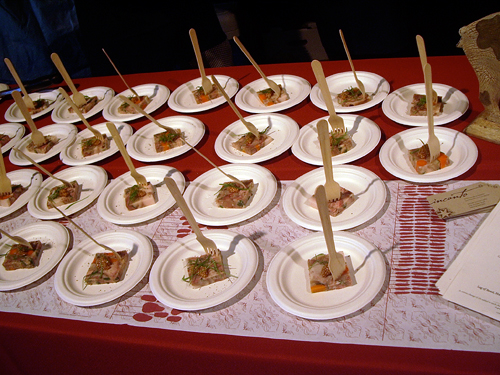
No pork crudo was in evidence, but there were plenty of jiggly slices of "head and hoof" terrine topped with pickled mustard seeds. (Made by Chris Cosentino of Incanto, as if you had to ask).
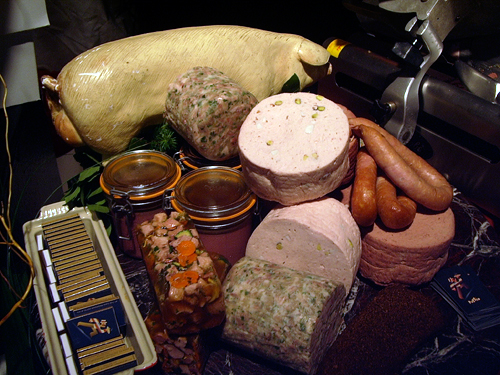
Poggio's Peter McNee laid out a lavish spread of salume, all made from a single pig, including sliced "pigstrami," mortadella, chocolate-brown "bloodella," and more, plus poached cotechino sausage over lentils (a classic Bolognese pairing) and fermented summer sausage on sauerkraut.
Homer Simpson would have been in heaven ("Porkchops and bacon, my two favorite animals!") but after the sixth or seventh porky bite, the octopus tentacles made by A16's Liza Shaw starting looking mighty good.
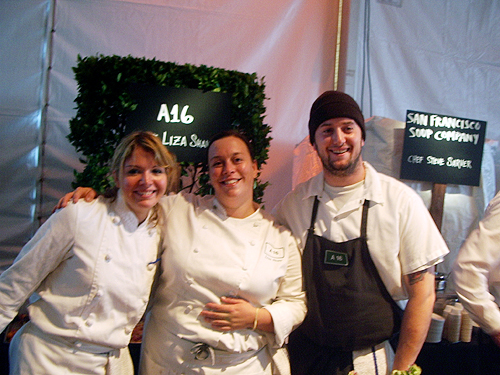
Nicolette Manescalchi, Liza Shaw and Ross Wunderlich
Why octopus? "Well, I love squid, octopus, all that stuff." said Shaw. Sometimes you have to choose between cooking for the people or cooking for chefs. Today, I decided to cook for the chefs. The people will follow!"
And her octopus tentacles on a stick, with slippery onion and a vivid, herby green-tomato salsa verde, were double-plus good.
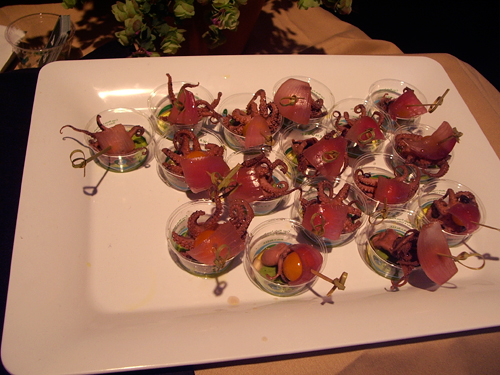
You could wash down all that pork with many different cocktails, as long as your taste ran to tart, dry, and spicy. San Francisco bartenders continue to love their bitters, from the aromatic bitters (made from cinnamon, allspice, cardamom, and cassia) in the Rye Buck (Wild Turkey, house-made ginger syrup, lime) from Rye to the orange bitters in the cayenne sugar-rimmed Smoking Gun (Combier orange liqueur, Hennessey Black cognac, smoked peach puree) from Otis.
Everything seemed to have lemon or lime, ginger or cinnamon, plus a dash of herbal/anise flavor, in the form of Chartreuse, Herbsaint, or absinthe. Acknowledging that bartenders have their groupies and their name-brand just like chefs, each bar table had a board announcing the bartender's name and his (yes, they were all male) liquor of choice above the table.
The next morning, it was time for the Anolon Chef Challenge: Restaurant Family Feud (Delfina vs. Spruce), hosted by the Food Network's Aida Mollenkamp and judged by Jan Newberry, Steffan Terje (Perbacco, Barbacco) and Chronicle editor Miriam Morgan. The same conference room was now a Top Chef-style kitchen, with portable cooktop (but no running water), myriad bottles of wine and olive oil, and both a secret ingredient and a mystery basket of seasonal produce, courtesy of CUESA.
The secret ingredient? Local sustainable seafood, including Monterey Bay squid, sardines, and sole. The produce basket had just about everything you could find at Ferry Plaza: tomatoes of all sizes and colors, new potatoes, corn, herbs, figs, nectarines, melons, plums, onions, leeks, and more. The challenge? Three courses, one hour, two chefs on each team.
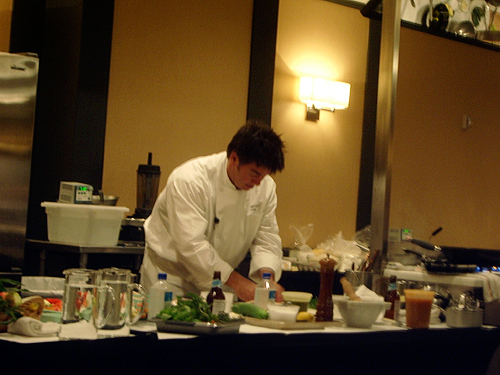
Mark Sullivan from Spruce
As you might imagine, chefs know how to focus, and halfway through their allotted time, you could hone a Wusthof knife off the single-minded attention beaming down from Delfina's Craig Stoll and Anthony Strong and Spruce's Mark Sullivan and Ben Cohn.
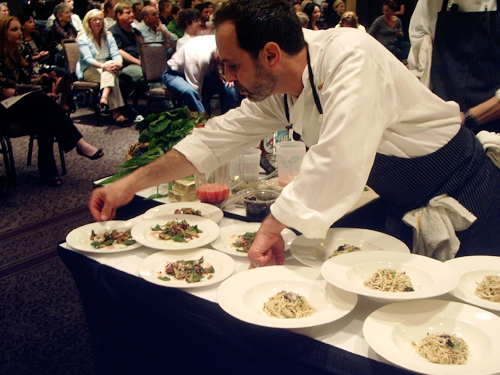
Craig Stoll from Delfina
They had little time or energy for chit-chat, which left Mollenkamp to carry the show, without TV's benefit of tomato-chopping close-ups or suspense-building commercial breaks. But the judges did chime in here and there, as when Mollenkamp asked Terje about his favorite summer produce.
"Summer is hard for me," Terje admitted. "It's like culinary ADD. Winter is more forgiving. Now, when something hits the market, you have to be ready for it right away."
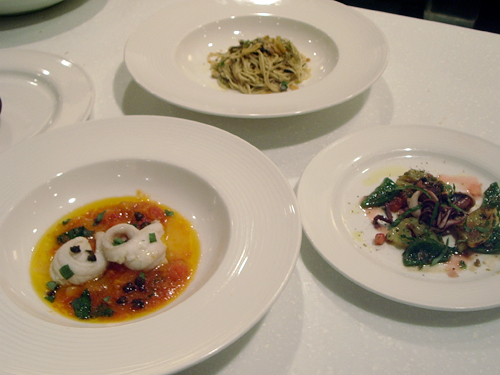
Delfina dishes
The final menus? For Delfina, handmade tonarelli pasta with sardines, fennel, grapes, capers, and toasted breadcrumbs, followed by an impromptu toss of charred peppers, anchovies, and poached squid with pureed and diced tomatoes, lemon, capers and olives, and finally rolled sole poached with fish fumet, white wine, and herbs over tomatoes stewed in tomato juice and camomile tea.
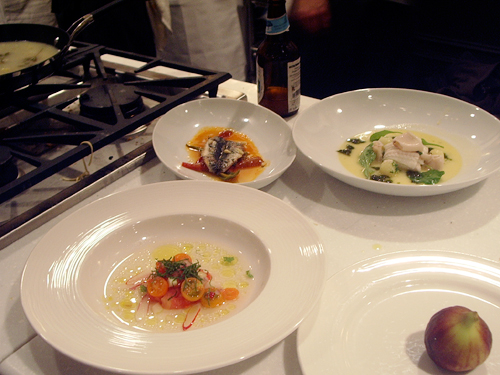
Spruce dishes
For Spruce, the meal began with a clear tomato-water gazpacho with diced tomatoes and mint, followed by seared sardine over a pork-and-tomato broth with peppers and smoked paprika, then poached sole and squid with leeks, potatoes, and a basil pistou.







